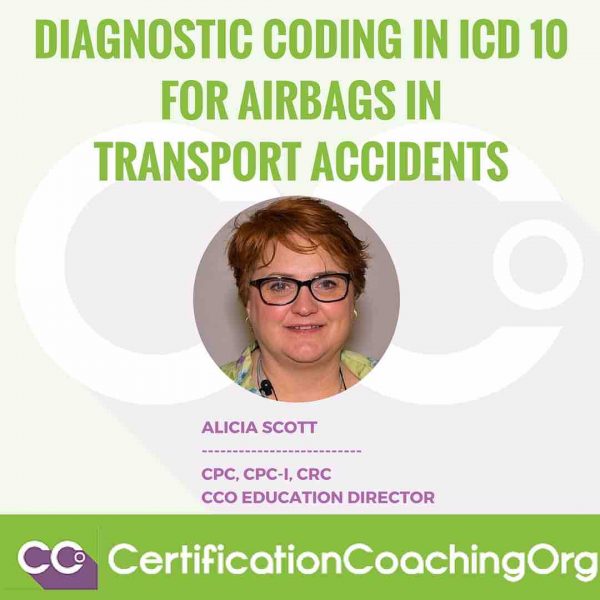Q: Diagnostic coding in ICD-10 for Airbags in Transport Accidents
A: I had so much fun looking this one up. The reason this is a really important one is that for testing purposes as well as real world coding, there are some things in ICD-10 that you may not be aware of that needs to be coded. Let’s start by saying that diagnostic coding for ICD-10, for airbags in transport accidents is in Chapter 20 External Causes of Morbidity and Transport Accidents (V00-V99).
I want you to note though, at the beginning of these codes, a specific comment you want to include in your manuals if it’s not there, is what I’m going to tell you. It’s in my Elsevier manual but it wasn’t in the manual that Chandra and I were talking about the other day. She said, “Is it in yours?” I said, “Yeah, it’s in mine.”
A transport accident, what is it? It’s very simple. Your vehicle or something moving; it has to be moving or running, and when it’s involved in an accident, then it’s considered a transport accident. The key though is that if your patient is in a transport accident, you want to use an additional code to identify these three things. The big one in my mind is airbags, that’s going to be W22.1 code; we’ll look at that a little more in-depth.
Diagnostic Coding in ICD 10 for Airbags in Transport Accidents Video

This next article, “Airbag Injury Risk Linked to Height” this is huge! And you know how they found this stuff out? By coders. This particular person wrote this article and I linked it here, this is how we know that children, they are too small to have an airbag. So you can now turn airbags off, if a child is going to be in the front seat, you turn it off; if you’re particularly small of stature where that be vertically challenged, then you are not going to have an airbag on. If you’re particularly tall, you are not going to have an airbag on. If you don’t tilt your steering wheel down, the airbag isn’t meant to hit you in the face, it’s meant to hit you in the chest. But a fantastic article here, it explains why we’re coding these.
The next thing that they wanted to know is what type of street or road did the accident happen on? The Y92.4, it extends out, but they want to know: was it a highway, was it paved, was it gravel? You think that doesn’t make any sense that that would be that important; but quite honestly it is. We have to remember we do this for statistical purposes. Also, if you didn’t know, gravel makes vehicles do things at a high speed differently than pavement.
Cell Phones – Y93.C2 – This should be almost self-explanatory for us now. I think it’s fantastic that we have a way to document the accidents on a medical standpoint if a cell phone was involved. You think why does the provider care if a cell phone is involved? Well, it’s going to make a difference in probably the type of accidents that occur – head- on collision is what I’m thinking – if a person is on a cell phone, it’s not that they run off the road and hit a tree. It’s that they swayed into the other lane of traffic a lot, and therefore we have head-on collisions. Head-on collision is all different area of trauma that the provider has to work with. Why does the payer want to know? Because it’s a whole list of… so many treatments that are involved with the head – on collision versus side impact quite frequently. Head-on is chest and body trauma; side impacts are head and neck trauma.
It’s assisting in the diagnosis of injuries, to have these statistics. It is also prospective treatments, that’s why the payer wants to; and statistical data. That’s why we code. We forget that so often, we get so caught up in getting your providers paid that we forget what we code today impacts our future. It changes laws. It changes treatments. So, be very aware of those. If you don’t have those codes noted, you need to be aware that they are pertinent and you definitely will be tested on those in the CPC.
Related Diagnostic Coding in ICD 10 for Airbags Posts:
- 2016 Medical Coding and Healthcare Trends
- Tips for Radiology Coding – CPT Codes for Radiology – Video
- Medical Coding Auditor Training At CCO – Video

![[CCO] Certification Coaching Organization LLC [CCO] Certification Coaching Organization LLC](https://www.cco.us/wp-content/uploads/2015/05/CCO-Logo-2015-d3-500px.png)
Great article Alicia. I printed it off so I can stick in my icd-10 book. Would be a good scenario for discussion on an upcoming webinar.